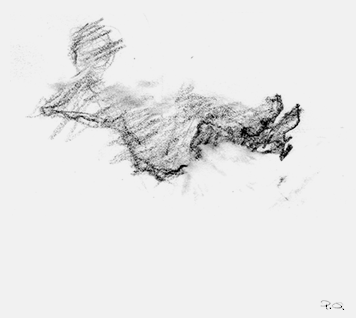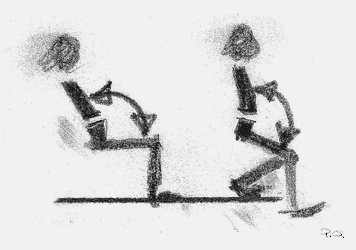What is your favourite postures?
Each part of the body has its favourite positions, but exactly which one is preferred at any given time is dependent on the positions the other parts of the body have assumed.
The extent to which bodily parts can have their “desires” fulfilled depends on freedom of mobility and opportunities for support.

The feet
When sitting on the floor to have a meal in a Japanese restaurant, the main problem is what to do with our legs. The main functional reason that we sit on elevated levels, stools or chairs is undoubtedly that it allows our legs and feet freedom on a lower level than the one at which we are sitting.
Each of the angles or positions our upper body assumes when we sit has its appurtenant “favourite positions” for the legs.
When we rest our upper bodies in a reclined position, we want to have our feet raised. When we are active, leaning our upper bodies over a table, we want our feet low.

The torso or middle regions
The human musculoskeletal system (also known as the locomotive system) is made up of soft tissue and bones. Our ability to move is due to these bones being connected by joints. When we move the body into the traditional sitting posture with the hips, knees and ankles all bent at 90-degree angles. Our ankles and knees are quite happy to bend to a 90 degrees angle. However, the hip joint stops bending after approximately 60 degrees and we make up the remaining degrees by straightening the curvature of the spine
A steep downward slope for the thighs (approximately 60 degrees angle in the hip) means that it is easier to retain the natural favourite curvature of the lumbar region.
The upper body is generally most comfortable when we are standing, so it is safe to assume that this upright posture ought to be the upper body’s favourite position, also when we are sitting. A prerequisite is that the lower body provides a good “open angle” permitting this posture.
What posture does the upper body prefer when we sit on a normal dining room chair? One thing is certain: we seldom sit with the upper body in conformity with the backrest angle that is typical for this type of chair. Reclining and leaning forward over the table is the two favourites.

Arms and hands
When we sit, we try instinctively to find a place to put our arms, and if we don’t find another place, we rest our arms on our laps. If we are sitting in a chair, there are more options, and if the chair has armrests these are of course a natural place to find support.
We like to have the support vertically beneath our shoulders, and this means that when we rest our forearms on the tabletop, this is not only to give our arms a break; it also takes body weight off the back.

The head
We sometimes feel the need to support our head. My solution is to make sure that there is a gap between the backrest and headrest to allow the shoulders freedom of movement. Just as pauses are important in music, gaps can be as important in furniture. When the backrest tilts, it does not simultaneously affect the position of the head rest.
This means you can retain the support for the lower back while at the same time getting full support for the head.
A space between the back and head support allows the user to sit sideways and use the top of the backrest as an armrest, and enjoy the same freedom as in a low-backed chair. The user is not limited to face forwards when sitting, as is the case in conventional high-back work chairs.

Chair profiles
Four body postures and three chair profiles.
Which of these three chair profiles provides the best support in all four postures?
The convex, the straight, or the concave seat and backrest profile?
Peter Opsvik´s thoughts about chairs and sitting
More about Peter Opsvik´s thoughts about sitting:
A historical view on sitting
Movement and variation
Tilting concepts
Chairs growing with the child
Some thoughts on design
Environmental values
Rethinking sitting – the book